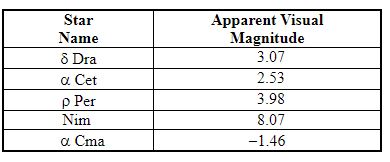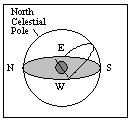Correct Answer

verified
Correct Answer
verified
Multiple Choice
What is the angle between the noon sun on the winter solstice and the southern horizon for an observer at a latitude of 38 N?
A) 38
B) 52
C) 75.5
D) 28.5
E) 14.5
Correct Answer

verified
Correct Answer
verified
Short Answer
_________ is the point in Earth s orbit when Earth is closest to the sun.
Correct Answer

verified
Correct Answer
verified
Multiple Choice
The diagram below shows three approximate locations of the sun along the western horizon. Which number indicates the location of the sun at sunset on June 21 for an observer at a latitude of 77 N? 
A) 1
B) 2
C) 3
D) The sun will not rise for an observer in the northern hemisphere.
E) The sun will not set on June 21 at this latitude.
Correct Answer

verified
Correct Answer
verified
Multiple Choice
During a total lunar eclipse, which of the following are true? I. The photosphere of the sun is obscured by the moon. II. The moon is in Earth s umbra. III. The moon is new. IV. The moon is full.
A) I, III
B) II, IV
C) I, II, III
D) II, III
E) I, II, III, IV
Correct Answer

verified
Correct Answer
verified
Not Answered
How are the celestial poles and equator defined by Earth s rotation?
Correct Answer

verified
Correct Answer
verified
Multiple Choice
Northern Hemisphere winters are colder than Northern Hemisphere summers because
A) Earth is closer to the sun during the summer than it is during the winter.
B) the snow that falls in the northern latitudes cools Earth during the winter.
C) the light from the sun shines more directly on the Northern Hemisphere during the summer.
D) the period of sunlight is longer during the summer than during the winter.
E) c and d
Correct Answer

verified
Correct Answer
verified
True/False
The third quarter moon rises at noon.
Correct Answer

verified
Correct Answer
verified
True/False
A 3 rd magnitude star is 3 times brighter than a 1 st magnitude star.
Correct Answer

verified
Correct Answer
verified
True/False
The celestial equator always crosses the horizon at the east point and west point.
Correct Answer

verified
Correct Answer
verified
Multiple Choice
The diagram below shows three approximate locations of the sun along the western horizon. Which number indicates the location of the sun at sunset on June 21 for an observer at a latitude of 37 N? 
A) 1
B) 2
C) 3
D) The sun will not rise for an observer in the northern hemisphere.
E) The sun will not set on June 21 at this latitude.
Correct Answer

verified
Correct Answer
verified
Not Answered
What two pieces of information are needed to determine the diameter of a far away object? Explain how that information is used to determine the diameter.
Correct Answer

verified
Correct Answer
verified
Multiple Choice
The phase of the Moon on a particular night is determined by
A) the season of the year.
B) the speed of the Moon in is orbit.
C) the relative positions of the Sun, Earth, and Moon.
D) how the Earth s shadow hits the Moon.
E) the distance from the Earth to the Moon.
Correct Answer

verified
Correct Answer
verified
Multiple Choice
Table 2-1
 -Refer to Table 2-1. Which star in the table would appear the brightest to an observer on Earth?
-Refer to Table 2-1. Which star in the table would appear the brightest to an observer on Earth?
A) a Cet
B) a CMa
C) Nim
D) r Per
E) d Dra
Correct Answer

verified
Correct Answer
verified
Multiple Choice
What is the approximate latitude of the observer in the diagram below? 
A) 90 N
B) 90 S
C) 50 N
D) 50 S
E) 0
Correct Answer

verified
Correct Answer
verified
True/False
A second magnitude star in Ursa Major is brighter than a fourth magnitude star in Orion.
Correct Answer

verified
Correct Answer
verified
Short Answer
The ____________________ period of the moon is the time required for one revolution of the moon around Earth with respect to the stars.
Correct Answer

verified
Correct Answer
verified
Short Answer
The __________ of the sun is not visible during a total solar eclipse.
Correct Answer

verified
Correct Answer
verified
Multiple Choice
The synodic period of the moon
A) is about 27.32 days long.
B) is the period of time for the moon to orbit Earth once with respect to the stars.
C) is the period of time between successive eclipses at a given location on Earth.
D) is the period of time from when the moon rises until the moon rises again the next night.
E) none of the above
Correct Answer

verified
Correct Answer
verified
Multiple Choice
The apparent visual magnitude of a star is 7.3. This tells us that the star is
A) one of the brighter stars in the sky.
B) bright enough that it would be visible even during the day.
C) not visible with the unaided eye.
D) very far from Earth.
E) very close to Earth.
Correct Answer

verified
Correct Answer
verified
Showing 61 - 80 of 165
Related Exams